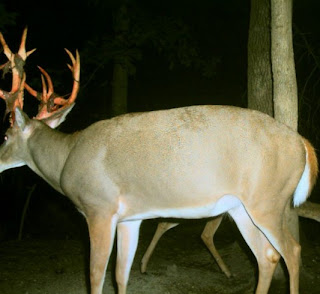Antlers are found on all members of the deer family(Cervidae) in North
America. Antlers are
true bone and are composed primarily of calcium and phosphorus and are
deciduous. Deciduous means antlers are dropped or shed and grown anew
each and every year. They grow from pedicles located on the frontal
bone of their skull. The pedicles begin growing at a very young age in buck fawns and provide the base from which the antler will grow. Deer grow their first
set of antlers when they are approximately one year of age. The skin or tissue that develops at the top of the pedicel reacts to
hormones in the deer body and actually causes an antler to
grow/develop. The most interesting aspect of this antler growth tissue
is that, if it is surgically removed and grafted to another part of the
deer’s body, an antler will grow there. Antler
growth begins by a bud forming on the pedicle. Within a month the
first tine will have begun to form or split off.
Approximately a month later, the second tine will have begun to
form. In just four months, the antlers are fully developed.
When the antlers are growing, they are full of nerves and blood vessels
and are covered with a hairy skin covering tissue commonly called
“velvet.”By late summer, as day length decreases, testosterone levels
begin to increase, the form is filled, and the antler begins to harden.
Finally the blood vessels within the antler itself are filled and lose
their ability to nourish the velvet, and it dries up and falls off.
The velvet is typically totally removed in a day, and some of it may be
eaten by the buck.
 |
| Velvet with small cracks and bleeding. Photo credit: W. Hill, 2010 - LINK |
 |
| Fallow deer: antler velvet peels off. Lisieux zoo, France. Photo credit: Stefan Ivanovich - LINK |
 |
| Photo credit: Susan C. Morse - LINK |
 |
| Velvet hanging in strips. Photo by W. Hill, 2010 - LINK |
|
 |
| Photo credit: Phillip Colla - LINK |
 |
| Photo credit: Jamie and Lisa Johnson - LINK |


















No comments:
Post a Comment